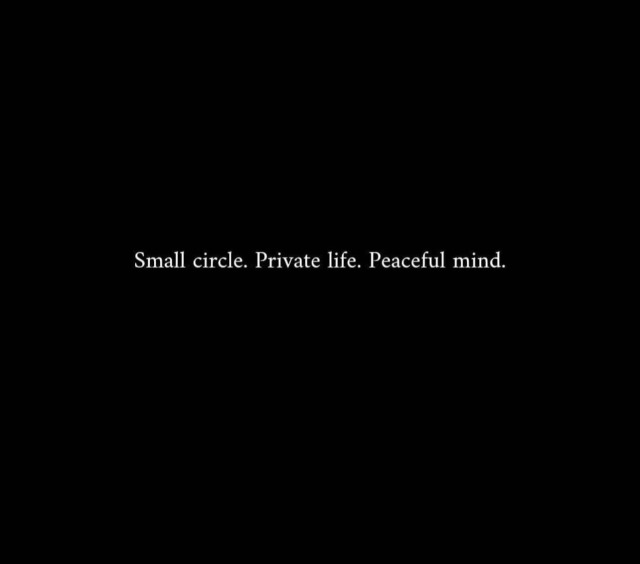Unlocking the hidden life of Frida Kahlo
A page which has remained on my desktop for years, to read and re-read regularly whilst brething in the pictures of a fascinating artist. From the BBC website published 18th June 2018 and written by Lindsay Baker.
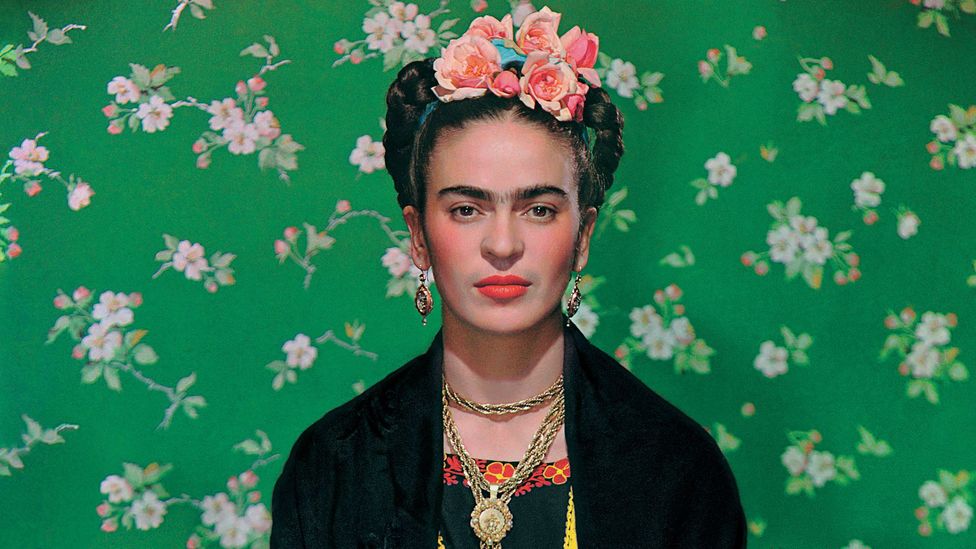
(Image credit: Nickolas Muray / Victoria and Albert Museum)
An exhibition in London displays thousands of the iconic artist’s clothes and possessions alongside her paintings.
“I paint self-portraits because I am so often alone, because I am the person I know best,” said the Mexican artist Frida Kahlo. And Kahlo’s iconic, cult status owes much to her striking self-portraits, in which she captured and interpreted her own distinctive visual identity. So much so, in fact, that a new exhibition asks: was Kahlo’s unique personal image as central to her myth and persona as her art? And what can her personal style and belongings tell us about her life and her art?
Intriguingly, until 2004, Kahlo’s clothes and other personal items had been locked away for 50 years in the Blue House, the casa-estudio or home and studio in Coyoacán just outside Mexico City that the artist shared with her muralist husband Diego Rivera. Following Kahlo’s death, Rivera had locked the 6,000 photographs, 300 personal items and garments, plus 12,000 documents, away in the bathroom of the house. When they were finally revealed, it took four years for historians to sort and catalogue them, and for the first time, these artefacts and clothes have left the Blue House to be displayed at London’s Victoria and Albert Museum.
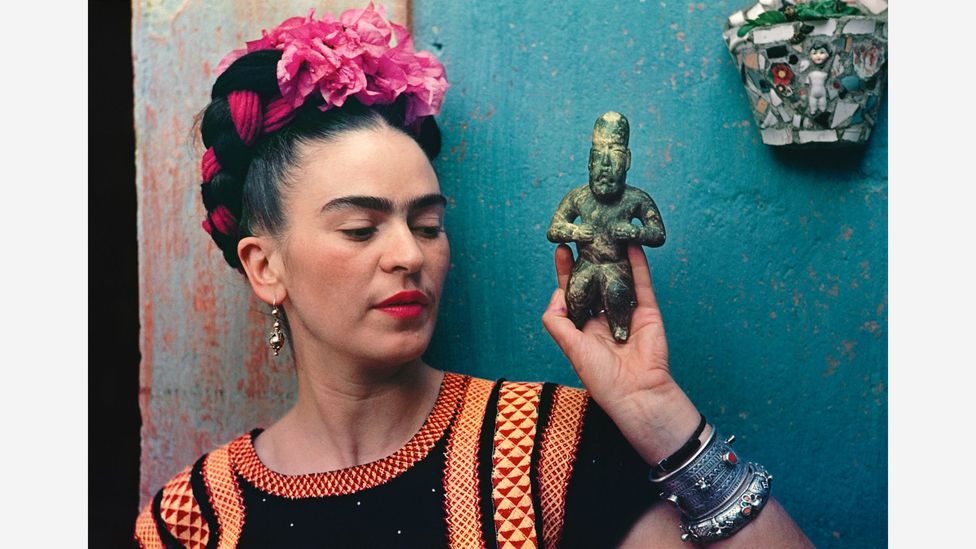
Frida Kahlo’s iconic status owes much to her striking self-portraits, like this one, with an Olmec figurine, from 1939 (Credit: Nickolas Muray/Victoria and Albert Museum)
In the exhibition Frida Kahlo: Making Her Self Up, the artist’s dresses and other personal effects are displayed alongside her paintings, showing the intimate connection between the two. She is presented as a kind of performance artist, whose whole self or identity was an extension of her art. Kahlo’s flamboyant Mexican dresses and bold floral headpieces are displayed, along with the hand-painted prosthetics and corsets that helped support and mask her physical disabilities. Much more was understood after the discovery of the objects about Kahlo’s accident. Items such as her medicines and orthopaedic aids help illuminate her story, and some of her supportive bodices and spine braces, including corsets that she painted with religious and communist symbols and imagery relating to her miscarriages.
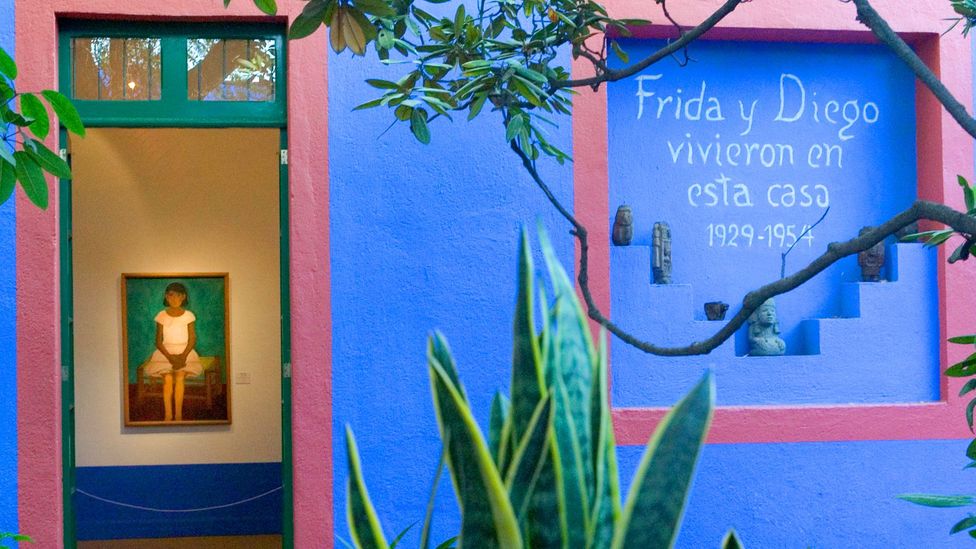
The thousands of photos, garments and documents had been locked away for 50 years in the Blue House, just outside Mexico City (Credit: Alamy)
Kahlo’s powerful style is as integral to her myth as her paintings – Circe Henestrosa
Exhibition co-curator Circe Henestrosa tells BBC Culture that the construction of Kahlo’s identity “around her politics, ethnicity and disability” is the central thesis of the show. “The exhibition aims to provide a personal, political and cultural context for Kahlo’s story. Kahlo suffered a devastating near-fatal accident at the age of 18, which rendered her bed-bound and immobilised. Much more is understood about Kahlo’s accident after the discovery of the objects in the Blue House, and the show illuminates this story through her medicines and orthopaedic aids.”
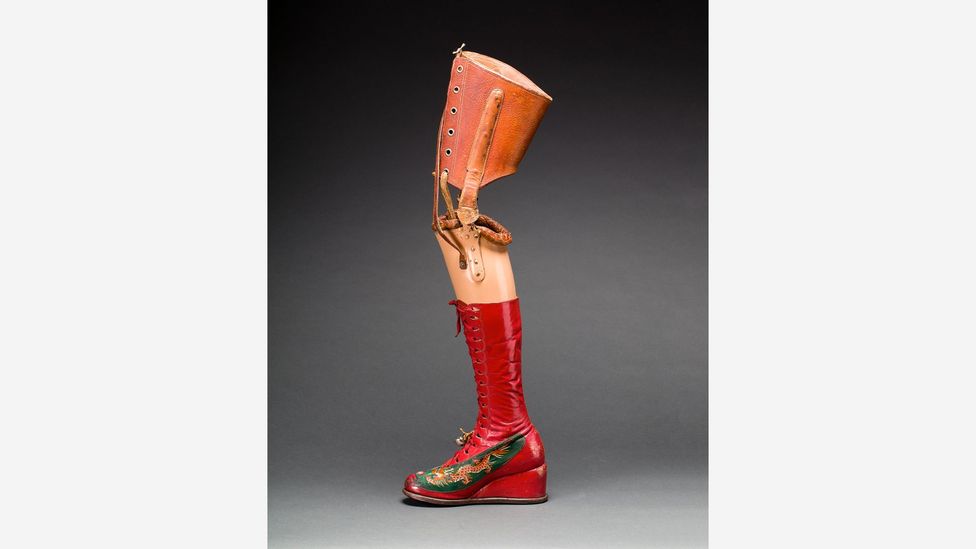
Many of the objects – such as her corsets and prosthetic leg – reveal more about Kahlo’s near-fatal accident at the age of 18 (Credit: Victoria and Albert Museum)
With the discovery of the artist’s personal effects, new insights are revealed about how Kahlo’s personal style was in part guided by her disabilities. “Clothes became part of her armour, to deflect, conceal and distract from her injuries,” says Henestrosa. “Kahlo endured multiple operations in both Mexico and the United States and had to wear orthopaedic corsets made of leather and plaster. Her corsets were necessary for medical reasons but she also elaborately decorated them. The traditional indigenous dress style she adopted allowed her to conceal these items under long skirts and geometric cut blouses.”
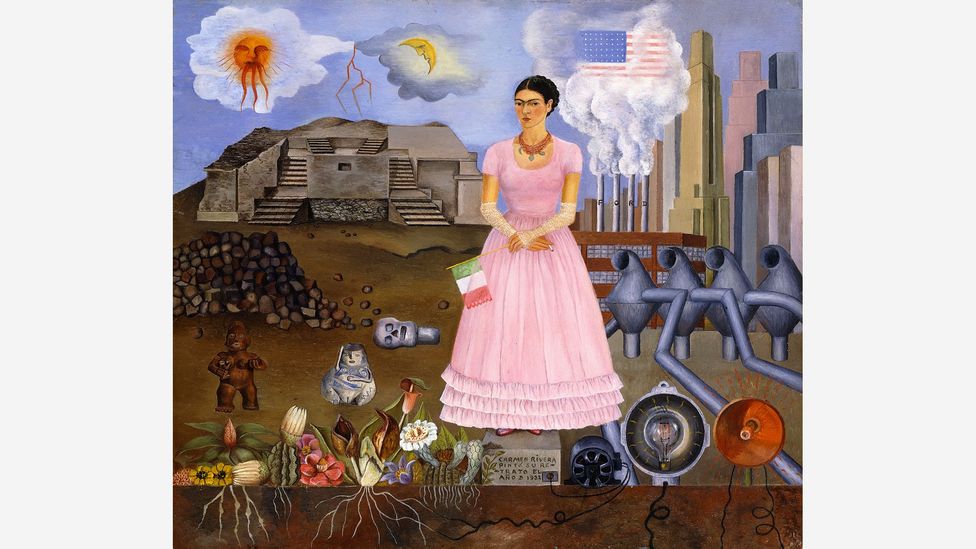
Objects are on display alongside paintings, including Self-Portrait on the Border Between Mexico and the United States of America (Credit: Modern Art International Foundation)
“I think Kahlo’s powerful style is as integral to her myth as her paintings. It is her construction of identity through her ethnicity, her disability, her political beliefs and her art,” says Henestrosa, who also curated the first ever exhibition of the artist’s wardrobe, at the Frida Kahlo Museum in 2012. By the time Kahlo adopted the traditional Tehuana dress, she wanted to look quintessentially Mexican, explains Henestrosa, and the Tehuana dress comes from the Tehuantepec Isthmus, a matriarchal society in the southeast of Mexico.
“Frida understood the power of dress from a very early age,” the curator explains. “As a result of her polio at the age of six, she was left with a withered and shorter right leg, something that led her to choose long skirts. She began wearing three to four socks on her thinner calf and also wore shoes with a built-up heel to mask her asymmetry. This shows how she established a relationship between her body and dress from a very early age. Through the use of her self-portraits and the use of traditional Mexican dresses to style herself, Kahlo dealt with her life, her political views, her health struggles, her accident, and her turbulent marriage.”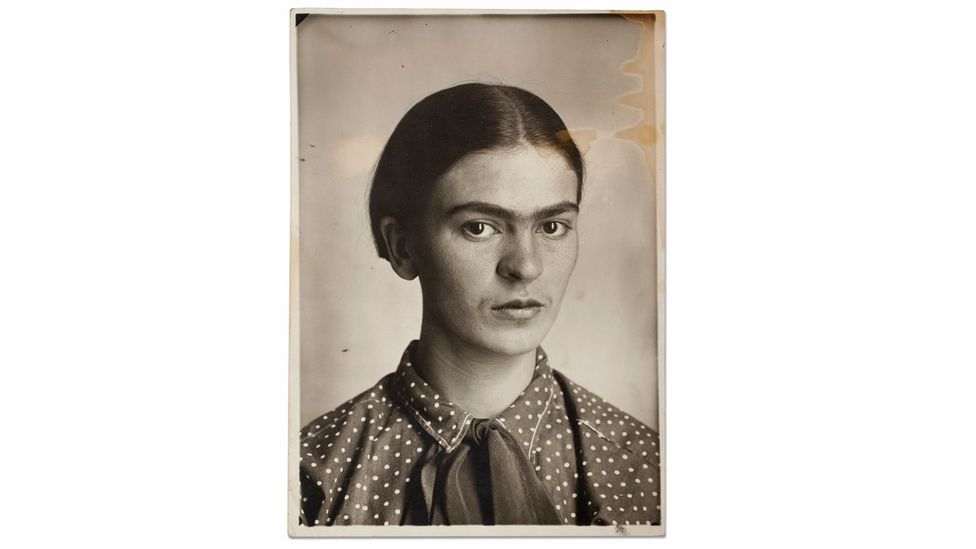
Frida is said to have used her self-portraits and traditional Mexican dresses to help her deal with her life and struggles (Credit: Victoria and Albert Museum)
The sense of unlocking hidden treasures is central to the exhibition, as its co-designer, Tom Scutt, tells BBC Culture: “There is such a spirit of time and place about this unique exhibition. The action of unlocking a room in the Blue House to discover all these belongings of Frida’s is echoed in the notion of arriving at an exhibition as a visitor and discovering the belongings oneself. Because of this, the exhibition holds an indisputable, magical charge.”
‘Duality, reflection, repetition’
The exhibition explores Kahlo’s childhood, and includes an album of architectural church photographs by her German father Guillermo Kahlo. Also shown are early photos and paintings of Kahlo and Rivera with their circle of famous friends, including Leon Trotsky. Kahlo’s cultural pride following the Mexican Revolution (1910-20) is also further illuminated by the previously hidden items – her interest in the arts, crafts and traditions of the indigenous people of Mexico was a passion. The period of the 1920s and 30s saw what became known as a ‘Mexican Renaissance’, with the country attracting artists, writers, photographers and film-makers from all over the world. Photographs by Edward Weston and Tina Modotti taken in the 1920s are also displayed. And there is a wall of ex votos from Kahlo and Rivera’s collection. The small, tin votive paintings that were offered up to the saints, were an influence on Kahlo’s art.
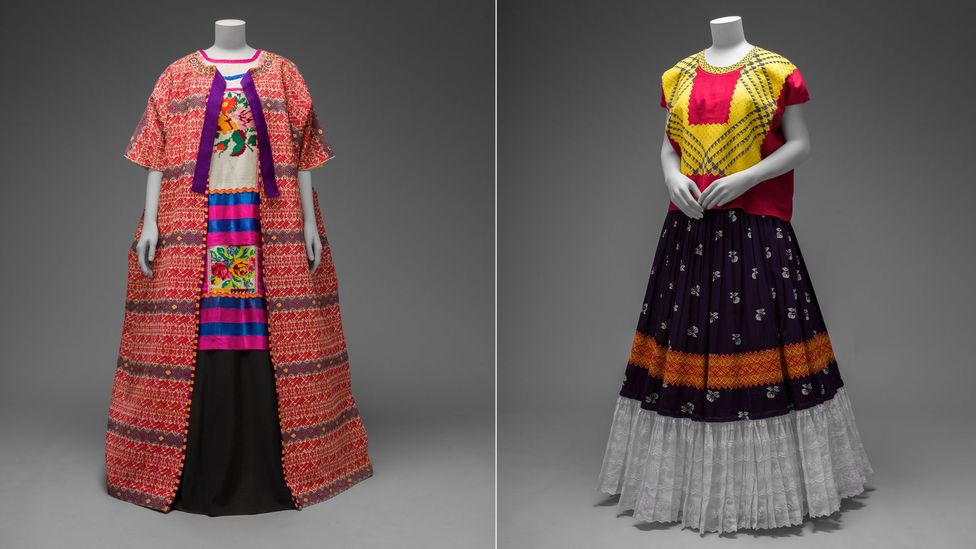
Garments displayed include the traditional huipil (embroidered tops), rebozos (shawls), long skirts and jewellery (Credit: Victoria and Albert Museum)
Garments on show include rebozos (traditional Mexican shawl), huipiles (embroidered square-cut top), enaguas and holanes, long skirts, and jewellery including Columbian jade beans and modern silverwork. There is a resplandor, a lace headdress traditionally worn by the women of Isthmus, alongside a portrait of Kahlo wearing it. And also on show is the artist’s original Revlon red lipstick and the kohl she used to define her famous, signature monobrow.
The aim was to create a pedestal in which the subject can speak for itself, says Scutt: “We hope we have created an experience that carries with it echoes, ghosts of ideas that are reminiscent of the influences in her life but always to have avoided pastiche. It should feel as much 2018 London as it does 1940s Mexico.
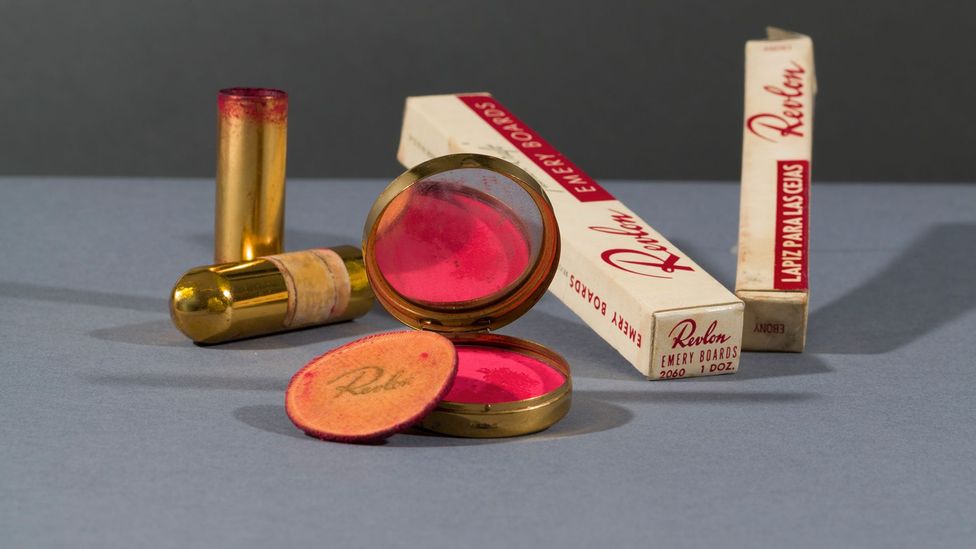
The artist’s original Revlon red lipstick and the kohl she used to define her famous, signature monobrow are on show (Credit: Victoria and Albert Museum)
“Frida’s life was full of duality and complex opposite ideas, the notion of looking at oneself in the mirror to paint a self-portrait therefore became central [to the exhibition],” says the designer. “It is this duality, reflection, repetition that we have tried to expand across the exhibition to give visitors a sense of the duality within her. I was also keen that we gave a sense of looking at the world from a different angle. There is a photograph that starts our exhibition of Frida reflected in the mirror that hung above her on her four-poster bed.
During Kahlo’s lifetime she was sometimes viewed as ‘exotic’ or patronised, ‘othered’ but today – her intersectional, and complex, self-constructed identity is better understood and is inspiring – Circe Henestrosa
“I really enjoyed the distorted world view that that image threw up and the ripples of what it means on a wider view about artistry and disability. I was very keen that the experience somehow embraced and reflected the notion of having a different perspective on the world, thus there are echoes throughout of tilting, leaning, sloping and angled surfaces that crack open and emit light from within. We took inspiration from Frida’s garden podium and I looked a lot at Mayan pyramids to examine the crossovers of this idea and pre-Columbian architecture. In this way we have attempted to fuse the very personal experience through Frida’s eyes, with a much wider sense of the world around her.”
‘Inherently modern’
Matt Thornley of Gibson Thornley Architects, who co-designed the exhibition with Scutt, says that Kahlo’s “complexity” is central.
“The outward image of Frida is so powerful,” he says. “The photographic portraits are bursting with colour and life, as are her paintings. The exhibition explores this but also her physical fragility and inner strength. It is these complexities that make her such an interesting and enduring figure.
And like the artist herself, the design of the exhibition is “inherently modern” says Thornley. “It acts as a backdrop to the objects and paintings that describe key events in her life. The exhibition explores Frida’s roots and her position within the wider context of art, culture and politics in 1920s and 1930s Mexico. However we didn’t want to imitate the imagery associated with this time. Instead the team were interested in exploring themes directly associated with her life. Working on the exhibition has allowed us to learn so much more about her – her strength in the face of personal adversity, her bravery and also humour.”
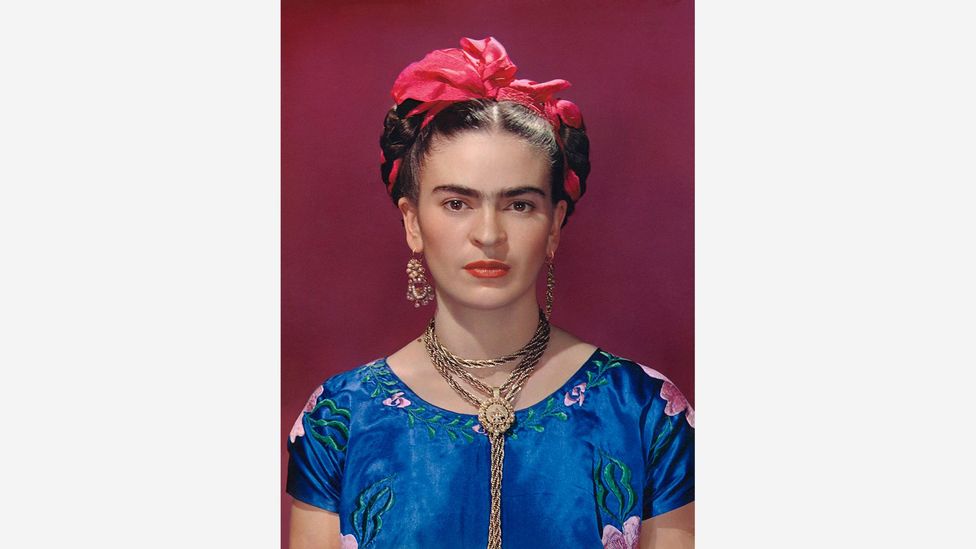
The exhibition explores the artist’s power, but also her physical fragility (Credit: Nickolas Muray/Victoria and Albert Museum)
Kahlo’s individualism, energy and modernity have made her an undisputed icon. But will she continue to influence future generations? Co-curator Circe Henestrosa thinks so: “Definitely,” she says. “Frida Kahlo is the very model of the bohemian artist: unique, rebellious and contradictory, a cult figure that continues to be appropriated by feminists, artists, fashion designers and popular culture. As a woman, an artist, an icon, Kahlo has achieved a rare, almost universal, acclaim. In a society often obsessed with tearing down the walls of the private self, Kahlo is the very embodiment of the ethos du jour. The dress choices she made reflected an intuitive ability to use a bold visual image in a time when men dominated the art world, and it was through art and dress that she conveyed her political beliefs at the same time that she dealt with her disabilities.”
And one thing is certain, Kahlo’s feminist and countercultural passions chime perfectly with current times. As Henestrosa puts it: “During Kahlo’s lifetime she was sometimes viewed as ‘exotic’ or patronised, ‘othered’ but today – her intersectional, and complex, self-constructed identity is better understood and is inspiring. So this is the message we want to convey in this exhibition. She was a Mexican, female artist who was disabled, looking for a place as a female artist in a highly male-dominated environment in Mexico City. Aren’t we fighting as women for the same today? How much more relevant, and refreshing for our times she can be?”
Frida Kahlo: Making Her Self Up is at the Victoria and Albert Museum, London from 16 June – 4 November 2018.
Updated/maj. 10-10-2022
Vues : 8


